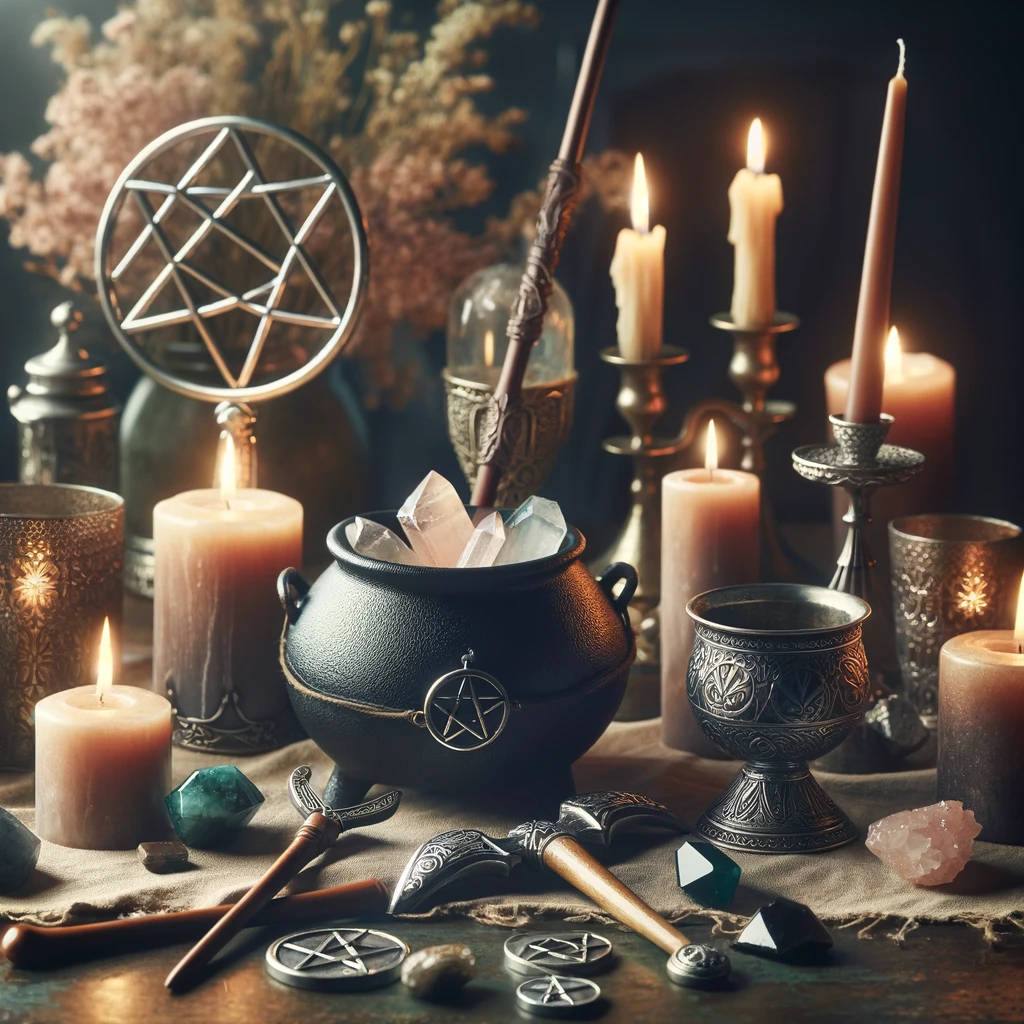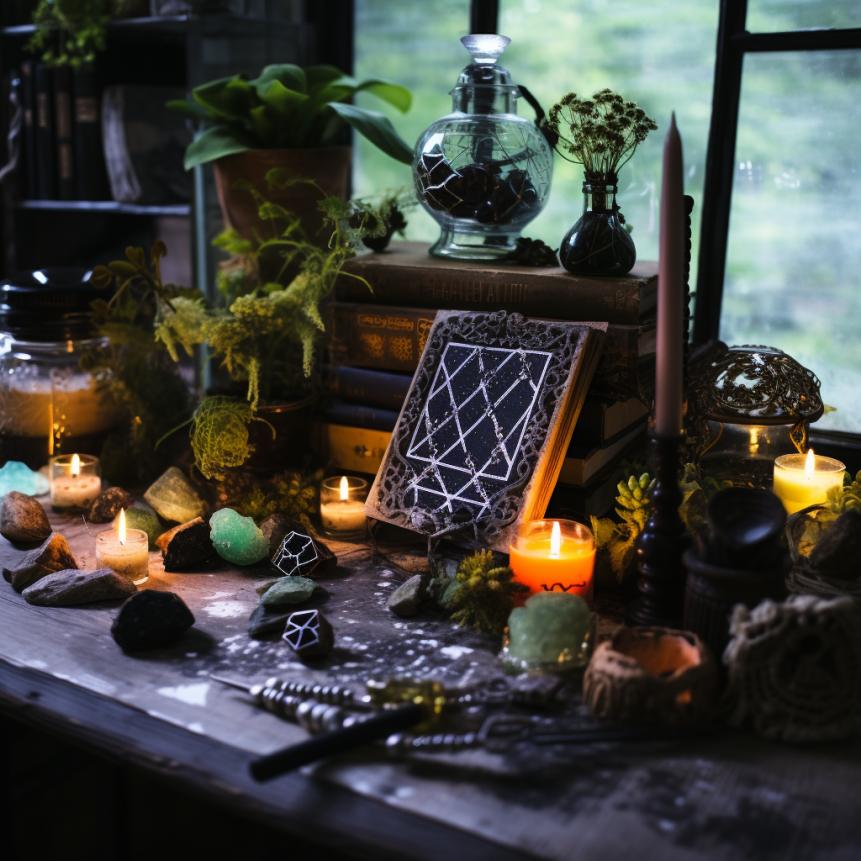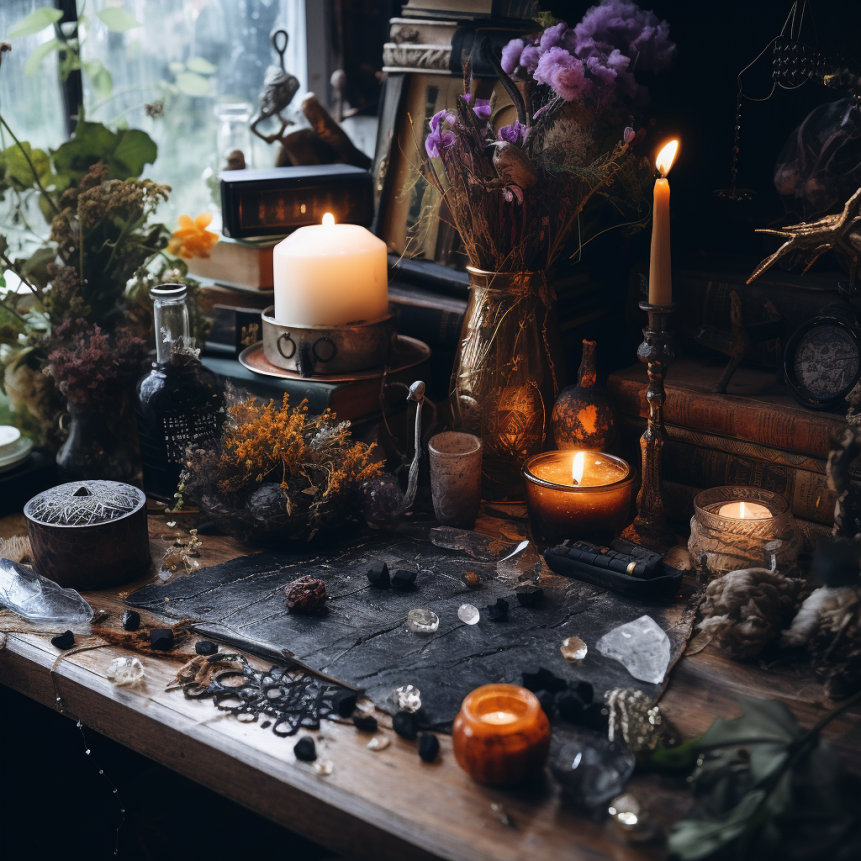What is an Altar?
An altar is a sacred space, deliberately set up to honor, worship, connect with, or invite a sense of the spiritual into your daily life. It acts as a focal point for religious or spiritual activities, such as prayer, meditation, or rituals. Often a personal and intimate space, an altar reflects the beliefs, intentions, and desires of the person who creates it.
Significance of an Altar
In various spiritual traditions, an altar holds immense significance. It’s often seen as a portal to the divine or the metaphysical world—a place where the veil between the earthly and the spiritual is thin. For example, in Pagan and Wiccan practices, an altar is not just a physical spot, but a symbol of their connection to the divine and the elements of nature: Earth, Air, Fire, Water, and sometimes Spirit. It’s a place to practice altar magic, make altar offerings, and perform ritual altar work respective to one’s spiritual path.
The Wheel of the Year
The Wheel of the Year is a spiritual and ritual calendar used by many Pagans, Wiccans, and other Earth-based spiritualities. It marks the changing seasons and the agricultural cycle, with each turn of the wheel representing a sabbat or holiday. These sabbats celebrate the moon phases, sun phases, and the cycle of life, death, and rebirth. The eight sabbats include Yule, Imbolc, Ostara, Beltane, Litha, Lammas, Mabon, and Samhain—each honoring a different aspect of nature, life, and the divine.
In the forthcoming sections, this article will explore how to set up an altar attuned to the Wheel of the Year. This includes aligning with the sabbats, integrating the five elements, and personalizing your practice for spiritual growth and connection with nature.
Whether you’re new to these traditions or a seasoned practitioner looking to refine your altar setup, this guide will offer insights into creating a space that embodies the cycles of nature and supports your spiritual journey.
Benefits of Setting Up an Altar for the Wheel of the Year
Setting up an altar in harmony with the Wheel of the Year brings numerous benefits, reinforcing one’s spiritual path and deepening the connection with the ever-changing flow of life. Here are some key advantages:
- Connection with Nature: It helps in aligning with the natural world, recognizing the significance of each season, and celebrating the earth’s bounty.
- Spiritual Significance: An altar acts as a dedicated space for spiritual practice—be it meditation, visualization, spellwork, or divination. It’s a place to honor deities, observe moon phases and sun phases, and acknowledge major astrological shifts.
- Personalized Practice: Your altar becomes an outward expression of inner beliefs and intentions. For Pagan and Wiccan altars, this personalization is key to enhancing the practitioner’s magical and spiritual journey.
Choosing a Space for Your Altar
When setting up an altar for the Wheel of the Year, consider these factors in choosing the appropriate space:
- Clean and Sacred Space: Look for a spot that can remain relatively undisturbed. This shot should be easy to cleanse both physically and energetically to maintain its sanctity.
- Indoor or Outdoor Location: An indoor altar offers privacy and protection from the elements, while an outdoor altar can deepen the connection with nature. Choose based on your living situation, climate, and personal preferences.
- Personalization: Tailor the space to reflect your spiritual path. Include altar decoration that resonates with you whether it’s Pagan or not.
Gathering Altar Items
Seasonal Items for Each Sabbat
For each turn of the Wheel, consider including items that correspond to the current sabbat. Here’s a brief overview:
| Sabbat | Seasonal Items |
|---|---|
| Yule | Evergreens, holly, candles |
| Imbolc | Brigid’s cross, white flowers, candles |
| Ostara | Eggs, rabbit representation, spring flowers |
| Beltane | Ribbons, Maypole symbolism, blossoms |
| Litha | Sun imagery, summer fruits, flowers |
| Lammas | Bread, grains, harvest tools |
| Mabon | Autumn leaves, fruits, cornucopia |
| Samhain | Pumpkins, ancestor photos, cauldron |

Symbolic Items for Each Element
Elements are central in Pagan and Wiccan practices:
| Element | Items |
|---|---|
| Earth | Crystals, stones, salt, pentacle |
| Air | Feathers, incense, wand |
| Fire | Candles, athame, images of the sun |
| Water | Chalice, bowl of water, seashells |
| Spirit (optional) | Central deity representation, ankh or similar symbol |
Arranging Your Altar
Once you have your items, it’s time to arrange your altar:
- Creating a Base with a Cloth or Runner: An altar cloth sets the stage, grounding the space. Colors can match the sabbat or element you’re honoring.
- Using Candles to Represent the Elements: Place candles to correspond with the directions and elements (e.g., yellow for east/air).
- Incorporating Crystals, Herbs, and Essential Oils: Crystals for earth, herbs for water (as they grow with water), and essential oils for anointing candles or diffusing.
- Using a Chalice or Cup to Represent the Goddess and a Wand or Athame to Represent the God: These are central Wiccan altar tools but can be used in any spiritual practice.
- Adding a Pentacle or Other Symbol of Protection and Grounding: A pentacle often acts as a focal point for grounding and protection.
- Incorporating a Symbol of the God or Goddess of the Season into Your Altar: Different sabbats highlight different deities; honor them with statues or artistic representations.

Maintaining Your Altar
To maintain the integrity of your altar space:
- Keeping it Clean and Free of Clutter: Regularly dust and declutter to maintain its sanctity.
- Smudging to Clear Negative Energy: Use sage, palo santo, or incense regularly to clear negativity.
- Updating Your Altar from One Sabbat to the Next: Transition your space as the Wheel turns, refreshing items in tune with the seasons and spiritual significances.

Embracing the Five Elements within Your Altar
A balanced altar integrates all five elements, encouraging harmony and holistic spirituality:
- Earth: Stability, nutrition, grounding. Use crystals, stones, or a bowl of earth.
- Air: Thoughts, wisdom, communication. Waft incense or feathers as representations.
- Fire: Willpower, transformation, courage. Include candles or images of fire.
- Water: Emotions, intuition, cleansing. Feature bowls of water or representations of bodies of water.
- Spirit (optional): The divine or greater connection. Place a deity figurine or an item that feels spiritually significant in the center.

Conclusion
Whether you’re celebrating Yule in the Southwest with its unique local customs or observing the balance of light and dark at Mabon, your altar is a living testament to the ever-turning Wheel. It’s a sacred space that evolves with the seasons and grows with your spiritual journey.
From choosing the right space to selecting and arranging meaningful items, these practices foster a connection to nature and the spiritual realm, offering a place for intention setting, gratitude, and manifestation.
Additional Resources
For those seeking to deepen their knowledge or expand their spiritual practice, here are a few resources to explore:








